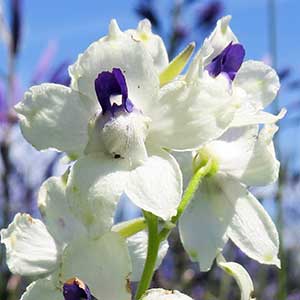Delphinium pavonaceum
Delphinium depauperatum
peacock larkspur
Blue Mountain, Blue Mountain larkspur, dwarf, dwarf larkspur, few flower larkspur, mountain larkspur, or mountain larkspur, slim larkspur
unbranched, 10-40(-70) cm;
base usually not reddish, nearly glabrous.
blade ± round, 1-5 × 1.5-9 cm, nearly glabrous; ultimate lobes 3-10, width 2-12 mm (basal), 0.5-3 mm (cauline);
margins of basal leaf, measured less than 1 cm from blade base, demarcating considerably more than 90° of arc when leaf laid flat;
cauline leaf blades much shorter than internodes.
3-15(-25)-flowered, open, ± secund;
pedicel 0.5-3(-7) cm, ± glandular-puberulent;
bracteoles 2-6(-12) mm from flowers, green to blue, linear or lanceolate, 4-5(-8) mm, ± glandular-puberulent.
sepals dark blue to bluish purple, puberulent, lateral sepals spreading, 10-14 × 4-7 mm, spurs straight, horizontal or nearly so, 12-16 mm;
lower petal blades somewhat elevated, ± exposing stamens, 4-7 mm, clefts 2-4 mm;
hairs mostly near base of cleft, white or light yellow.
9-16 mm, 3.5-4.5 times longer than wide, ± puberulent.
seed coat cells with surfaces roughened.
= 16.
Delphinium pavonaceum
Delphinium depauperatum
Delphinium depauperatum and D. nuttallianum are often found in the same meadows, with D. depauperatum occupying wetter sites, often very near streams, while D. nuttallianum is found in drier, better-drained sites. In typical years, the substrate will be dry around D. nuttallianum plants, while the substrate is damp near D. depauperatum plants as they flower. In addition, within a meadow, D. depauperatum flowers later than D. nuttallianum, so there is normally little overlap in flowering phenology of the two taxa. Although hybridization between D. depauperatum and D. nuttallianum is uncommon, hybrids do occur; they have been named D. ×burkei Greene. Burke's specimens at Kew represent a good series of permutations of this cross and successive backcrosses.
Specimens labeled Delphinium depauperatum subsp. harneyense represent the phase with more abundant yellow-glandular trichomes in the inflorescence and slightly larger flowers. Considerable variation in these features may be found within populations. Presence of yellow-glandular hairs is generally greater in more northern populations. Type specimens of Delphinium diversifolium are intermediate in amount of glandular pubescence.
Often confused with Delphinium nuttallianum, D. depauperatum may be distinguished by its cylindric inflorescences, less dissected leaves, winged seeds, and erect fruits. These character states contrast with the pyramidal inflorescences, more dissected leaves, ringed seeds, and spreading fruits of D. nuttallianum.
Dwarfed phases of Delphinium polycladon may be confused with D. depauperatum; they can be distinguished on the basis of bluish purple flowers, sigmoid pedicel, and prominent buds in the former, and dark blue flowers, straight pedicels, and absence of prominent buds in the latter.
(Discussion copyrighted by Flora of North America; reprinted with permission.)
- Local floras:
OR
- Local Web sites:
Flora NW,
PNW Herbaria
WildflowerSearch
iNaturalist (observations)
- LBJ Wildflower Center
- SEINet
- Plants of the World Online
- Encyclopedia of Life
- Wikipedia
- Google Image Search
